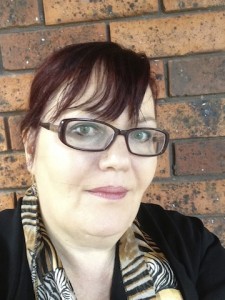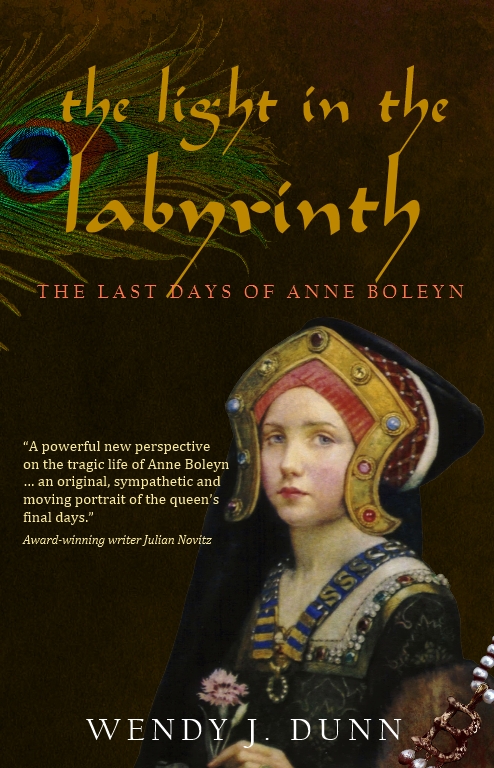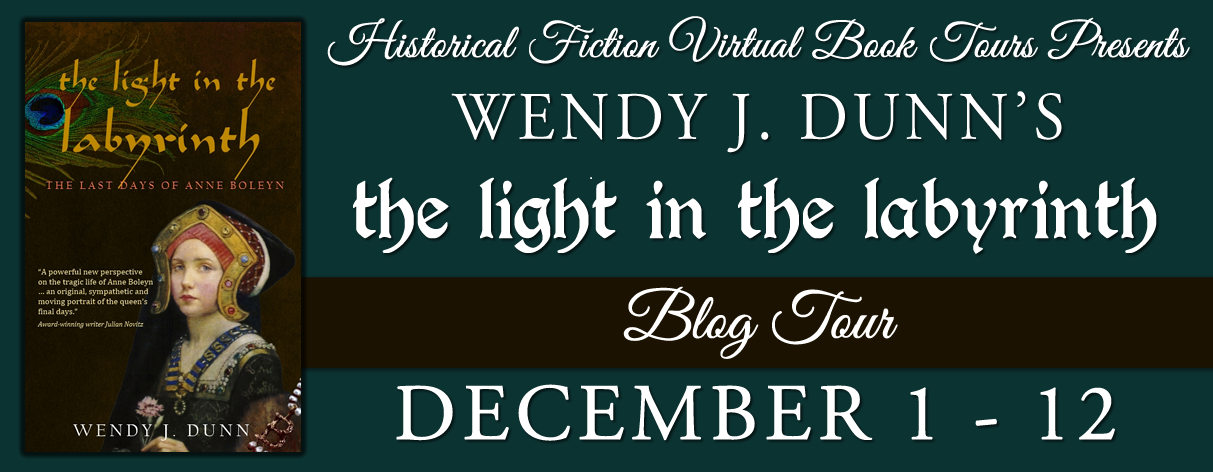Publication Date: September 7, 2014
Metropolis Ink
Paperback; 338p
ISBN: 098072192X
Genre: YA Historical Fiction
Blurb:
A Queen fights for her life.
A King denies his heart and soul.
A girl faces her true identity.
All things must come to an end—all things but love.
The Light in the Labyrinth, a young adult novel, depicts the lives of women in the patriarchal society of the Tudors, a time when aristocratic families commonly traded them for favour and status. Told from the perspective of a teenage Katherine Carey, niece of Anne Boleyn, this is a story of a girl who becomes a woman in the court of Henry VIII, the bloody tyrant remembered so well by history.
Unhappy at home with her mother, who has remarried, Kate receives permission to go to court to attend her royal aunt. In the past, Kate idolized her aunt from a distance; now given a place amongst her aunt’s trusted women, she becomes an eyewitness to the intrigue and heartache of Anne Boleyn’s final months as queen.
My Review:
I was excited to read and review Wendy J. Dunn’s book The
Light in the Labyrinth, because it was about Anne Boleyn. I am a fan of pretty
much any book that has to do with Anne Boleyn, or is even related to the time
period that Anne Boleyn was alive in. It was just a fascinating time of life to
read about, in my opinion. Even though the books are about the same subject a
lot of the time, they never get boring, because there is so much to write about
that period of time! Plus, no one knows exactly what happened, so there is a
lot of room for a writer to be creative, without ticking off too many history
buffs!
This was another good book about Anne Boleyn. I like when
the books about her are told by an outside perspective. The books that are told
from her perspective do get a little old, because how many different ways can
you tell one person’s story? This story is told from her niece, Kate’s, point
of view. Kate is her sister, Mary’s daughter, most likely a bastard of the
kings. Kate is close enough to the queen to know what’s going on within the
inner circle, but she is also able to be objective about everything, because she
is not involved. At first Kate is not very likable. She is selfish, spoiled,
and rude to her mother and step-father. However, she had gone through a lot at
a young age, and she was still young and immature. She had a lot of growing up
to do, and court was the right place for her to do that. There’s a little bit
of a love story throughout the book and there are also plots where Kate has to
become less naïve in order to avoid. Throughout the novel, Kate does a
lot of growing up, and she begins to make mature decisions.
Overall I enjoyed reading this book. It was an easy read,
and the writing style was smooth flowing. I would recommend The Light in the
Labyrinth to anyone who loves historical fiction, especially those of you who
love Tudor Historical Fiction! I give this novel a FOUR out of FIVE stars!
Guest Post:
Writing Anne Boleyn – by
Wendy J. Dunn
Yes – I
confess. I have an Anne Boleyn obsession, well and truly proven by writing not
one, but two novels that have Anne Boleyn in a starring role. But why write two novels about this tragic Queen?
The answer to that is rooted in the time when I emerged from my first Anne
Boleyn novel.
Dear Heart, How Like You This? (2002) tells
the story of Anne Boleyn through a fictional reconstruction of Sir Thomas
Wyatt, the elder, a real poet of Tudor times who wrote several poems that
suggest a strong connection to Anne Boleyn. Decades ago, I connected to the
poem I will always think of Dear Heart,
How Like You This? My first novel resulted
from that connection and became a canvas for me to ask: “What does it mean to
love?” Writing it also left me with many unanswered questions about the events
leading up to Anne Boleyn’s death in 1536.
It is far too easy to say Anne was executed because she failed to
provide Henry with his prince. Only one living son, a son who lived to maturity,
would have secured Anne’s position as Queen – as it would have secured the
position of Katherine of Aragon, too. Anne’s failure to provide England with a
prince was part of the cause for her downfall, but not all.
Little suggested at the beginning of 1536 the tragedy that would befall
Anne Boleyn in May of that year. Even at the beginning of April, just weeks
before Anne Boleyn's arrest, all seemed well. That was the moment in time when
Henry was very pleased to see the Spanish ambassador at last prepared to
recognise Anne as his Queen. The beginning of April was also the time when the
political landscape darkened for Cromwell, causing him to fear he had angered
the King. Perhaps that is enough to explain why a plot to remove Anne swung
into action. By April 1536, Cromwell and Anne were firm enemies. It is possible
that he feared Anne would use the weakening of his position to make true her
threat of the previous year and have him executed.
For
years, I mulled over what had really spurred Henry VIII to murder Anne Boleyn; that
unanswered question propelled me to take up the challenge of another Anne
Boleyn novel: The Light in the Labyrinth.
Writing fiction has long been a way for me to gain knowledge – about the Tudors,
about life and about myself. Through writing a novel that strived to be fair
and just to all the people involved, I wanted to illuminate for myself possible
answers as to what may have happened in 1536.
About twelve weeks pregnant at the start of 1536, Anne was no doubt
praying hard that this pregnancy would result in the triumph of a living son.
After giving birth to Elizabeth in 1533, she had suffered at least one
miscarriage. The failure of Katherine of Aragon to give Henry VIII a son was
seen as God making his displeasure known about their marriage; now the same
interpretation cast its shadow over Henry’s marriage to Anne.
Marriage to Henry had brought Anne Boleyn many reasons for sorrow. Even
in her first pregnancy, Anne had faced the reality of Henry's wandering eye.
Anne was a woman of great pride and jealous temperament. She found it
impossible to ignore Henry’s interest in other women. But Anne was now Henry’s
consort – and expected to provide England with its prince.
The birth of a son was extremely important to her, too. With the death
of Katherine of Aragon on January 7th, 1536, and a question mark
lingering over the legality of her marriage, only a son would secure her
position as Henry's Queen.
Henry VIII and the pregnant Anne Boleyn marked the death of Katherine of
Aragon by a time of celebration. To be fair, we don’t need to see these
celebrations as utterly callous. A living Katherine meant a constant threat
that her powerful nephew, Charles V, might decide to declare war and invade
England on her behalf.
Part of the festivities was a joust, in which the King took part. It was
a joust that almost cost him his life. Thrown from his horse, Henry VIII was unconscious
for at least three hours. When the King
revived, he appeared as a man who had faced the terror of his own mortality. The
jousting accident was followed not long afterwards by Anne’s miscarriage. She
miscarried their son, almost sixteen-weeks into her pregnancy. From that time
to not long before her arrest, a period of about ninety days, as recounted by
historian Alison Weir in The Lady in the Tower, history shows Henry VIII
swinging one way to another in his relationship with Anne Boleyn (Weir 2010).
After the King emerged from visiting his grieving wife in the birthing
chamber, he proclaimed, "I see God will not give me male children”. Anne
had failed him – and England – for the last time. Freed from her, he could seek
to make a 'bon fide' marriage to another woman. Already, Jane Seymour had
caught his attention, but – just like Anne had done for years - she refused to
be his mistress. Cromwell, who had taken Jane Seymour under his protection, no
doubt encouraged Henry VIII to consider Jane as a suitable candidate as his
bride.
After Anne Boleyn miscarried her son, Cromwell seemed to wait patiently
for the right moment to begin his plot in earnest. I believe Henry VIII’s head
injury in 1536 played an important part in Anne’s downfall. This head injury
seemed to have pushed Henry into fearing that he would die without a son. It is
very possible Cromwell seized on that to his own advantage. Always fearful for his personal safety, it also
seems that Henry became concerned Anne’s drive to move towards a doctrine that
no need for a “go between” between God and man would challenge the crown.
Anne Boleyn received a lot of bad and undeserved press during her
lifetime, and even more after her death. Henry VIII is believed to have said, not long after
Anne’s last abortive pregnancy, that he was ‘seduced and forced into his second
marriage by means of sortileges and charms’ (Warnicke 1987, p. 256). Anne Boleyn was no witch. She was a woman who loved her daughter, a
woman who also said children are the greatest consolation in the world.
I believe a lot of her 'bad' behaviour stemmed from living on her
'nerves', plus the immense insecurities of her position, which saw her, for
years, navigate a difficult course to marry Henry VIII. Anne knew she had many
enemies, one her own uncle, the Duke of Norfolk, who didn't take kindly to her
Lutheran leanings and independent spirit. Anne also lacked the training of
Katherine of Aragon, who had been taught to take on a Queen's mantle from the
time she was in her swaddling clothes. But I believe most wives would not
behave well if their spouse expected them put up with mistresses, saying – like
Henry VIII did when she was heavily pregnant with Elizabeth – "Shut your
eyes, do as your betters had done, and endure”.
Yes – Anne Boleyn had a temper and a very strong personality. She also
was a person who liked to and did speak her mind, but as the mother of
Elizabeth could we expect any less? Anne Boleyn was a proud and intelligent
woman who often disregarded what was expected of her time. Determination to
have her voice heard for the political and religious direction of England
brought her to when Henry VIII chose to violently remove her from his life,
persuaded that her lack of silence and self-effacement provided evidence of
treason and lack of chastity. As Heale (1995) writes:
‘The dangerous tightrope courtly women had to tread between wit and
scandal, pastime and offence is suggested by the daunting advice of Giuliano,
in The Courtier: ‘And therefore muste
she keep a certaine meane verie hard, and (in a manner) derived of contrary
matters, and come just to certain limittes, but not to passe them’ (Heale 1995,
p. 298).
Writing
The Light in the Labyrinth has
brought me to a belief that Anne’s death came about not simply because she
failed to provide a son to Henry VIII, but because of a heady mix of politics
and religion (Ives 2004: VI) one and the same in the Tudor period. Anne’s religious beliefs was taking England to a place that
threatened the King’s power as God’s representative on Earth, as God’s voice
for the English people. I believe Henry, manipulated by Cromwell,
convinced himself of the need to silent her voice and therefore erasing her
from his life.
No wise person dared to speak directly of Anne Boleyn to the King after
her execution. The subject seemed ‘to have remained taboo’ (Weir 2010, p. 319).
Only when Anne’s daughter Elizabeth was crowned Queen, even if simply to
rehabilitate the reputation of the Queen’s mother (Freeman 1995, p. 798), were
memories of Anne Boleyn given free voice again.
The history of both Katherine and
Anne Boleyn, indeed all the wives of Henry VIII, narrate how the lives of Tudor
women’s were dictated by their gender, and by a male dominated world. Women had
as much power as men allowed – power that could be taken away from them at a
snap of a man’s fingers. The tragic fates of Anne Boleyn and Katherine Howard
show how their lives could be taken from them, too. My way to rehabilitate and
give justice to Anne Boleyn’s memory is to enable her voice by fiction.
Works cited:
Dunn,
WJ 2002, Dear Heart, How Like You This?, Metropolis Ink, Yarnell, AZ.
Dunn,
WJ 2014, The Light in the Labyrinth, Metropolis Ink, Yarnell, AZ.
Freeman, T. S. 1995 ‘Research, Rumour
and Propaganda: Anne Boleyn in Foxe’s Book of Martyrs’, the historical journal
38(4)
Heale,
E 1995 ‘Women and the courtly love
lyric: the Devonshire MS (BL additional 17492)’, Modern Language Review, vol. 90, no. 2, pp. 296-313.
Warnicke, Retha M. 1987 ‘Sexual
Heresy at the Court of Henry VIII’ The Historical Journal Vol. 30, No. 2,
Cambridge University Press, at http://www.jstor.org/stable/2639194 (accessed August 20 2011).
Weir,
A 2010, The Lady in the Tower: The Fall
of Anne Boleyn, Ballantine Books, New York.
Buy the Book
Amazon UK
Amazon AUS
Barnes & Noble
Book Depository
IndieBound
About the Author
 Wendy J. Dunn is an Australian writer who has been obsessed by Anne Boleyn and Tudor History since she was ten-years-old. She is the author of two Tudor novels: Dear Heart, How Like You This?, the winner of the 2003 Glyph Fiction Award and 2004 runner up in the Eric Hoffer Award for Commercial Fiction, and The Light in the Labyrinth, her first young adult novel.
Wendy J. Dunn is an Australian writer who has been obsessed by Anne Boleyn and Tudor History since she was ten-years-old. She is the author of two Tudor novels: Dear Heart, How Like You This?, the winner of the 2003 Glyph Fiction Award and 2004 runner up in the Eric Hoffer Award for Commercial Fiction, and The Light in the Labyrinth, her first young adult novel.While she continues to have a very close and spooky relationship with Sir Thomas Wyatt, the elder, serendipity of life now leaves her no longer wondering if she has been channeling Anne Boleyn and Sir Tom for years in her writing, but considering the possibility of ancestral memory. Her own family tree reveals the intriguing fact that her ancestors – possibly over three generations – had purchased land from both the Boleyn and Wyatt families to build up their own holdings. It seems very likely Wendy’s ancestors knew the Wyatts and Boleyns personally.
Born in Melbourne, Australia, Wendy is married and the mother of three sons and one daughter—named after a certain Tudor queen, surprisingly, not Anne.
Wendy tutors at Swinburne University in their Master of Arts (Writing) program. She also works as a literature support teacher at a primary school.
For more information please visit Wendy J. Dunn's website. You can also find her on Facebook, Twitter, and Goodreads.
The Light in the Labyrinth Blog Tour Schedule
Review & Giveaway at Bookish
Tuesday, December 2
Review & Interview at The Tudor Enthusiast
Wednesday, December 3
Review & Giveaway at Peeking Between the Pages
Thursday, December 4
Guest Post at The Tudor Trail
Friday, December 5
Spotlight at A Leisure Moment
Monday, December 8
Review at 100 Pages a Day-Stephanie's Book Reviews
Tuesday, December 9
Review & Giveaway at The Eclectic Reader
Thursday, December 11
Review at WTF Are You Reading?
Review, Guest Post, & Giveaway at Historical Fiction Obsession
Friday, December 12
Spotlight at Passages to the Past
- This giveaway is for one ebook of The Light in the Labyrinth.
- Giveaway is open Internationally.





No comments:
Post a Comment